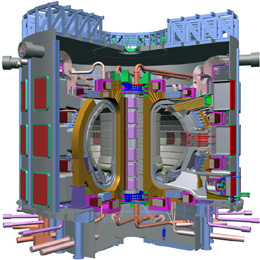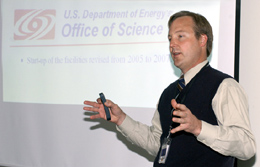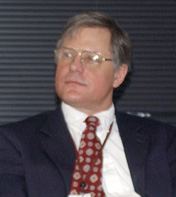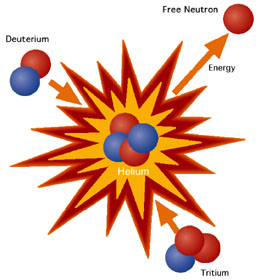 |
|
Burning Plasma: The Future of Fusion Energy by Elizabeth Clements
Almost all activities on the surface of the earth are ultimately powered by the sun,whether by today’s sunshine or by fossil fuels formed millions of years ago. What if it were possible to harness the physical process at work in a star here on the earth —- to develop an environmentally attractive and sustainable energy source available to all nations and modeled on the fusion process in a star? The main objective of the international fusion research project,ITER (which in Latin means “the way ”),is to develop and demonstrate the science and technology of fusion power for peaceful purposes. If successful, ITER would produce 500 megawatts of fusion power for 500 seconds or longer during each “shot” of the fusion experiment,with a repetition period of roughly 2000 seconds.In contrast,the Tokamak Fusion Test Reactor at the Princeton Plasma Physics Laboratory, one of ITER’s predecessors that shut down in 1997, produced a maximum of 11 megawatts for only one-third of a second. With global energy consumption increasing yearly,the sources remain primarily fossil fuel resources such as coal,oil and natural gas,with some contribution from nuclear power.Fossil fuels have a significant impact on the environment in the form of greenhouse gases,as well as the ways in which they are extracted from the earth.Limited and localized resources are also a source of geo-political instability,making alternative energy sources more attractive. These factors led President Bush to announce on January 30,2003 that the United States would join negotiations for the construction and operation of ITER.In his statement,President Bush said,“The results of ITER will advance the effort to produce clean,safe,renewable,and commercially- available fusion energy by the middle of the century...We welcome this opportunity to work with our partners to make fusion energy a reality.” The president’s decision to enter negotiations was based on an extensive process that included the 2002 Snowmass Fusion Summer Study of major next steps, a Fusion Energy Sciences Advisory Committee study of strategies 2003 for the study of burning plasmas,the interim report of an on-going study by the National Research Council,and a cost assessment by the DOE Office of Science.
Developing new energy sources will also mean developing new methods of collaboration and cost-sharing.The current estimated cost for the construction project is $5 billion,requiring an international collaboration to shoulder all of the responsibilities.ITER proposes to form an inter- national collaboration of nearly-equal partners. If successful,the ITER model could pave the way for future global science collaborations, such as the Global Linear Collider. Canada,the European Union,Japan and the Russian Federation were the members of the ITER collaboration immediately prior to the U.S. joining (or re-joining;the U.S.was a partner until the late-90’s when Congress withdrew from ITER for budgetary reasons). The U.S.and China are the newest members,and South Korea has recently expressed an interest in joining. With such a large international collaboration,the U.S.must first prepare for negotiations by conducting cost estimates for a range of possible in-kind contributions;then,identify the U.S.mission and objectives,compile the U.S.interests,and seek to find scenarios mutually beneficial for all the partners. In early March, Dr.N.Anne Davies, Department of Energy Associate Director of Science for Fusion Energy Sciences, named Princeton Plasma Physics Laboratory’s (PPPL) Ned Sauthoff as U.S.ITER Planning Officer, and Charles Baker of the University of California at San Diego as deputy.Davies cited Sauthoff’s background in international collaborations and project management. Baker is the director of the U.S.fusion program’s Virtual Laboratory for Technology. As U.S.ITER Planning Officer, Sauthoff’s main objective is to engage the fusion community and to build on the studies forming the basis for the president’s decision. To foster effective participation by the fusion community, Sauthoff formed the Burning Plasma Program Advisory Committee (BPPAC).This advisory committee consists of physicists from institutions across the nation who will examine the components the U.S.would be interested in contributing,and the roles the U.S.sees for itself in the ITER project,as well as other tasks. BPPAC is evaluating current successful models of international collaboration,such as the Large Hadron Collider located at CERN. On April 29-30,BPPAC met with the LHC group at Fermilab to learn from their management experi- ence as part of one of the largest international collaborations at CERN.Although the groups come from different scientific communities,the challenge of working in a large global collaboration is common.
Jim Yeck,the DOE/NSF U.S.LHC Project Manager,who organized the meeting,recognizes the importance of scientific communities working together. “The future of high-energy physics depends on the success of such large global collaborations as the LHC and ITER,”he said.“The LHC group is happy to help because we have experiences that are relevant.In large projects,you encounter issues of international relations,but the bottom line is that scientists want to do science.Scientists will do whatever it takes to extend the field of research.” Speakers at the meeting included Deputy Director Ken Stanfield,US-CMS Research Program Manager Dan Green,USLHC Accelerator Project Manager Jim Strait,and the Head of Fermilab ’s Office of Project Management Oversight,Ed Temple.Yeck noted that “a consistent message from the LHC people is the importance of strong central management.” BPPAC plans to examine other models of international collaboration and does not expect to complete its analysis until the end of the summer. The ITER project hopes to begin construction in 2006 and become operational in 2014.Canada, France,Spain and Japan have all submitted offers to host ITER,but further negotiations are necessary to reach a consensus.Sauthoff cited the importance of contact with the LHC project. “We have had a very fruitful interaction with the LHC group,”Sauthoff said.“Both LHC and ITER are big science adventures and we have not had enough opportunities to share our experiences. I’m looking forward to more beneficial interactions.” Fusion is a theoretically simple physical process: the binding of the nuclei of two similar atoms. For example,the nuclei of deuterium (one proton and one neutron)and tritium (one proton and two neutrons)can be forced to bind together.The result will then split into a neutron and a helium nucleus, with two neutrons and two protons —otherwise known as an alpha particle —plus another particle that does not carry much energy.The mass of the two incoming nuclei is greater than the mass of the product.This loss of mass translates into energy, which can both heat the plasma and provide power for useful work.
The fusion reaction is sustained in what is called a “burning plasma,” a nearly fully-ionized gas in which the fusion power captured by the plasma keeps the plasma hot.A burning plasma is dominated by this self-heating; however,this condition has not yet been achieved in a laboratory. The dynamics of the self-heating will be a funda- mentally new and key feature studied in ITER. The plasma, in this case an ionized gas of deuterium and tritium nuclei, will be heated by an external source to a temperature of at least 100 million degrees centigrade.Once this temperature is reached,the deuterium and tritium nuclei will begin to fuse,forming helium nuclei and neutrons. These magnetically-confined helium nuclei will then collide with deuterium nuclei in the gas,transferring some of their energy to the deuterium nuclei and heating the gas further.The plasma becomes self- heating —like a star —and a strong external energy source is no longer necessary. ITER would be the first magnetic confinement fusion experiment to produce burning plasma. The reaction would produce ten times the amount of external power injected into it. “By the time our young children reach middle age, fusion may begin to deliver energy independence and energy abundance to all nations rich and poor,”said U.S.Secretary of Energy Spencer Abraham.“Fusion is a promise for the future we must not ignore.”
ON THE WEB: DOE-Office of Fusion Energy Sciences: http://www.er.doe.gov/feature/fes.htm Official ITER Website: http://www.iter.org/
|



